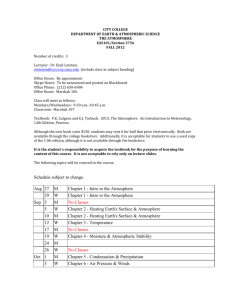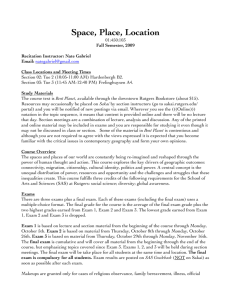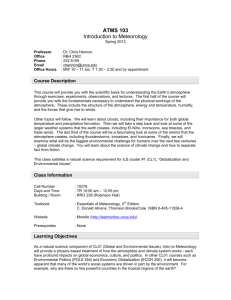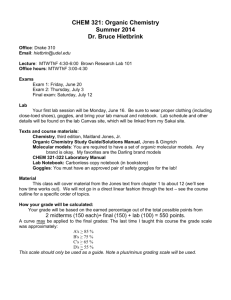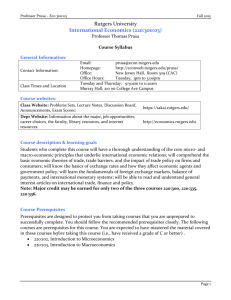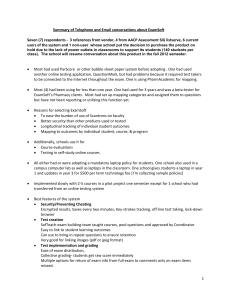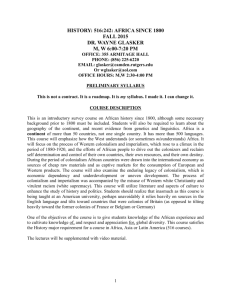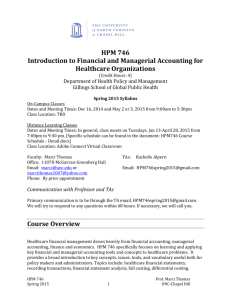670:201 – Elements of Meteorology Fall 2014
advertisement
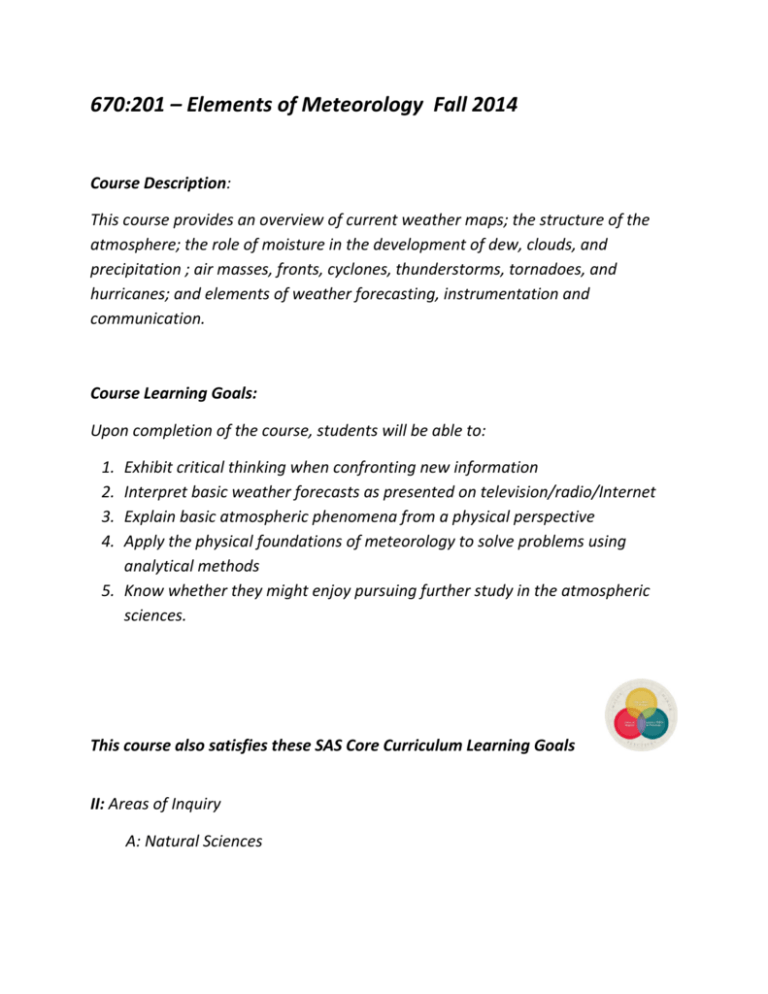
670:201 – Elements of Meteorology Fall 2014 Course Description: This course provides an overview of current weather maps; the structure of the atmosphere; the role of moisture in the development of dew, clouds, and precipitation ; air masses, fronts, cyclones, thunderstorms, tornadoes, and hurricanes; and elements of weather forecasting, instrumentation and communication. Course Learning Goals: Upon completion of the course, students will be able to: 1. 2. 3. 4. Exhibit critical thinking when confronting new information Interpret basic weather forecasts as presented on television/radio/Internet Explain basic atmospheric phenomena from a physical perspective Apply the physical foundations of meteorology to solve problems using analytical methods 5. Know whether they might enjoy pursuing further study in the atmospheric sciences. This course also satisfies these SAS Core Curriculum Learning Goals II: Areas of Inquiry A: Natural Sciences e. Understand and apply basic principles and concepts in the physical and biological sciences. f. Explain and be able to assess the relationship among assumptions, method, evidence, arguments, and theory in scientific analysis. z. ITR (technology) Lecture: Room 024 Loree building Douglas campus Section 01 Tuesday/Friday period 2 (10:55-12:15 Section 02 Tuesday/Thursday period 4 (2:15-3:35) Prerequisites: none Credits: 3 hours Satisfies: Gen Ed for Physical Sciences (Area II) for SEBS student SAS core curriculum for Natural Sciences (Area II) for SAS students Instructor Contact Information: Keith Arnesen arnesen@envsci.rutgers.edu Office: Room 358 ENR building/Cook 14 College Farm Road New Brunswick, NJ 08901 Office hours: Mondays 1-4pm Tuesday 4-5pm Other times by appointment REQUIRED RESOURCES Textbook: required, Essentials of Meteorology : An Invitation to the Atmosphere. 7th edition C. Donald Ahrens. (Earlier editions are okay, it is up to the student for any of the slight changes from the current 7th edition) Thompson-Brooks Pub. (study guide not required) Webpage: We are using Sakai for our course website. From Sakai you can obtain Exam grades, resources, announcements, chat room, etc. https://sakai.rutgers.edu/portal COURSEWORK Activities: Each class will begin with a map discussion. This will consist of projecting on-line, up to the minute information using satellite, radar, computer models and surface weather station information to show the present state of the atmosphere and how it might change over time. This is not intended to be a “note taking” time. It is intend to integrate information as the semester progresses to give the student an understanding of the workings of our atmosphere. Several videos will be shown throughout the semester to reinforce key principles. Homework: There is no formal points awarded for homework. Students are encouraged to form study groups through the Sakai chat room. Students should be able to answer the questions at the end of each chapter. If this is accomplished then success on the exams should follow. Any questions you find too challenging can be brought to office hours for clarification. Exams: Exams are the mechanism of evaluating your understanding of the key topics of the course. The format of the question will be multiple-choice and therefore several #2 pencils and clean erasers along with calculators (no cells phones) are a necessity. The first 3 exams will be given during class time and the final exam will be the University schedule. (Missed exams will only given a makeup with an appropriate letter from your Dean or your personal physician) Each of the first 3 exams are standalone material but he final exam is cumulative but heavily weight on the final section. Tentative exam dates Exam 1- September 30 Exam 2- October 28 Exam 3- November 20 Final exam – December 15 8 a.m. GRADING You are graded on your competency, not your effort. We will use a straight grading scale in this class- no curve. This is a very fair and generous scale that will not change based on class performance. Exams 1,2 and 3 will be worth 23.33% each for a total of 70% The Final exam will be worth 30% A 88-100% B+ 84-87.9% B 78-83.9% C+ 74-77.9% C 65-73.9% D 55-64.9% F Less than 55% COURSE POLICIES Extra assistance: The preferred method of obtaining extra assistance is to come to office hours. You may also ask questions that will have short answers by email. Class courtesy: You are expected to be respectful of fellow students and me. Examples of courtesy include: Turning off cell phones and other sound-making devices before class Not distracting your classmates by talking or making other noises Not surfing the web or checking email or texting Not eating or drinking Academic Integrity: The University policy about academic integrity can be found at website http://academicintegrity.rutgers.edu/. Special Needs: To ensure that disability-related concerns are properly addressed from the beginning, students with disabilities who require reasonable accommodations to participate in this class are asked to see the instructor as soon as possible with the appropriate documentation. COURSE PLAN Introduction, history and instrumentation Chapter 1 The Earth’s atmosphere Station Plotting 2 Warming the Earth and the Atmosphere 3 Air temperature 4 Humidity, condensation and clouds 5 Cloud Development and precipitation 6 Air pressure and winds 8 Air Masses, Fronts and Middle Latitude Cyclones 9 Weather forecasting 10 Thunderstorms and Tornadoes 11 Hurricanes 15 Light, Color, and Atmospheric Optics
